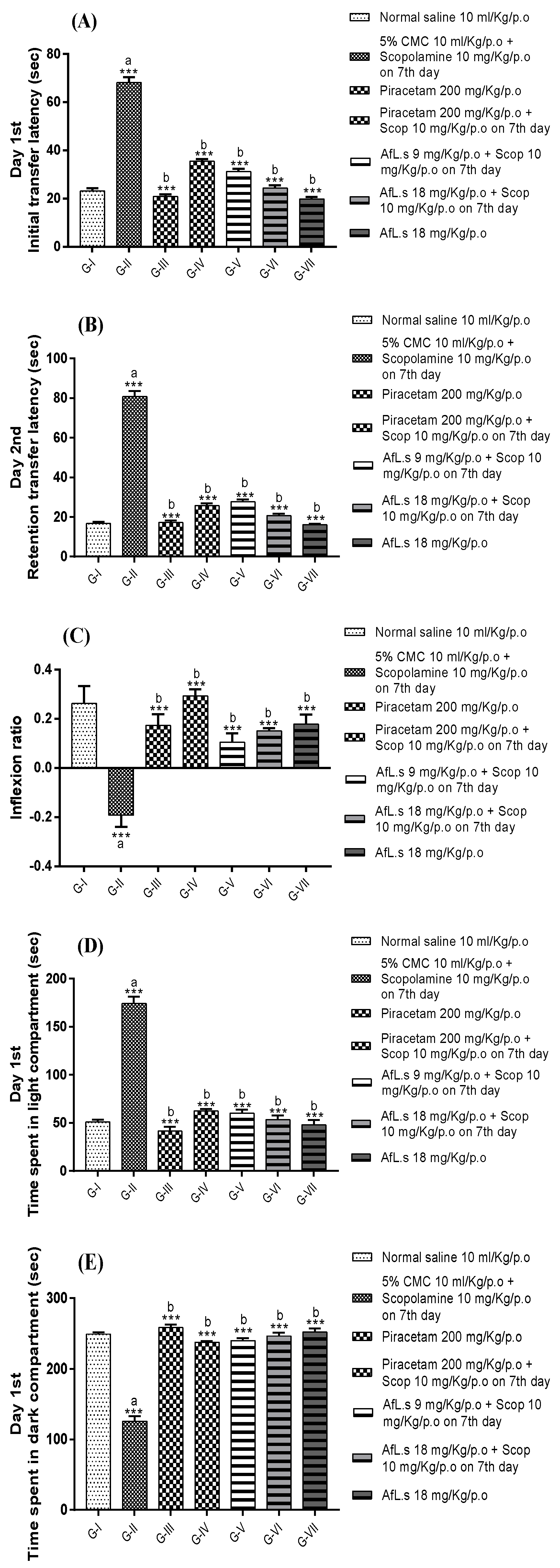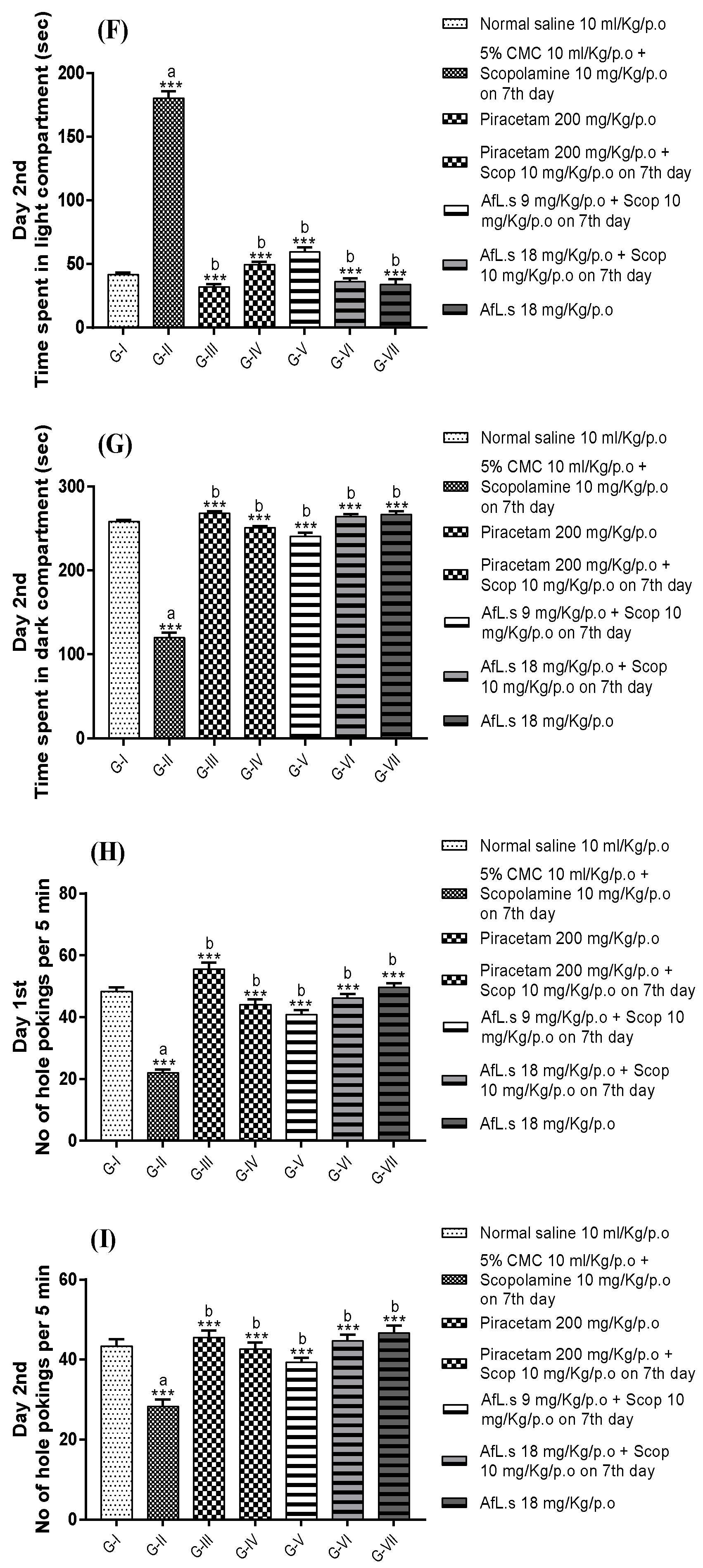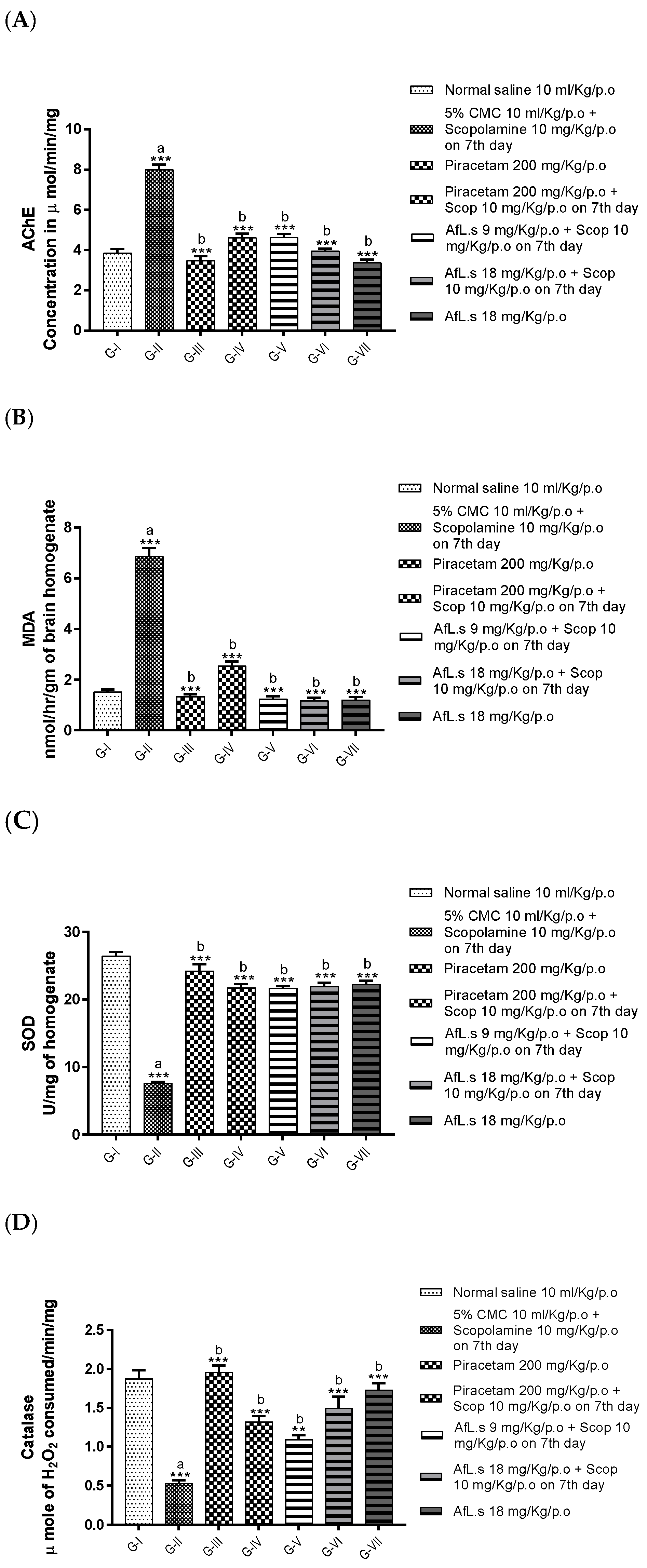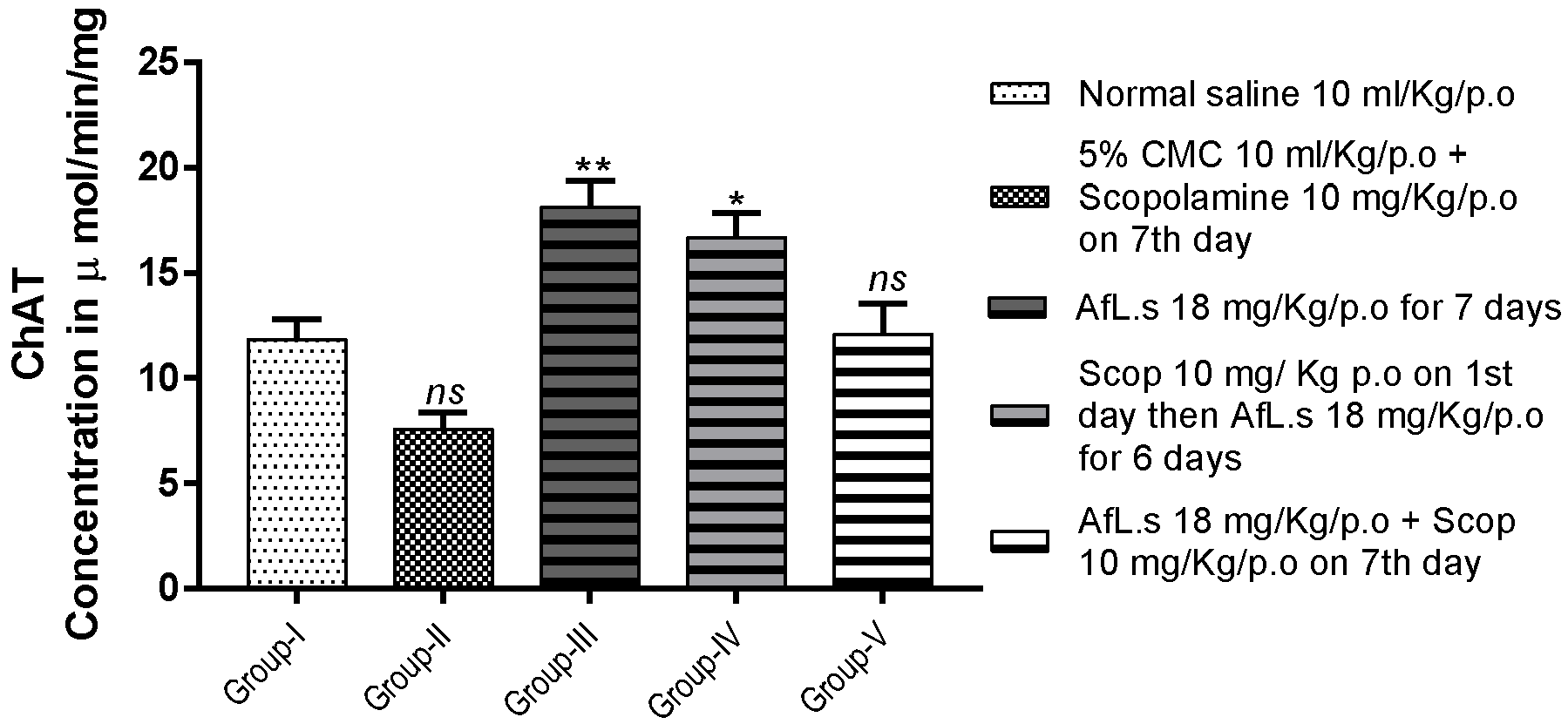Biomolecular Evaluation of Lavandula stoechas L. for Nootropic Activity
Abstract
:1. Introduction
2. Materials and Methods
2.1. Chemicals and Drugs
2.2. Extraction and Fractionation by Column Chromatography
2.3. Anti-Cholinesterase Activity (In Vitro Assay)
2.4. GC–MS Analysis
2.5. Behavioral and Biochemical Studies
2.6. Animals
2.7. Study Design for Behavioral/Biochemical Studies
2.8. Choline Acetyltransferase Activity (ChAT)
2.9. Acute Toxicity Studies
2.10. Statistical Analysis
3. Results
3.1. Fractionation by Column Chromatography
Anti-Cholinesterase Activity (In Vitro)
3.2. GC–MS Analysis of AfL.s
3.3. Behavioral Studies (Effect of AfL.s on EPM, Light/Dark Test, and Hole-Board Paradigm in Mice)
3.4. Biochemical Studies (Effect of AfL.s on Levels of AChE, MDA, SOD, CAT, and GSH in Mice Brains)
3.5. Effect of AfL.s on ChAT Activity
3.6. Acute Toxicity Study
4. Discussion
5. Conclusions
Supplementary Materials
Author Contributions
Funding
Institutional Review Board Statement
Informed Consent Statement
Data Availability Statement
Conflicts of Interest
References
- González-Tejero, M.; Casares-Porcel, M.; Sánchez-Rojas, C.; Ramiro-Gutiérrez, J.; Mesa, J.M.; Pieroni, A.; Giusti, M.; Censorii, E.; de Pasquale, C.; Della, A.; et al. Medicinal plants in the Mediterranean area: Synthesis of the results of the project Rubia. J. Ethnopharmacol. 2008, 116, 341–357. [Google Scholar] [CrossRef]
- Benítez, G.; González-Tejero, R.; Mesa, J.M. Pharmaceutical ethnobotany in the western part of Granada province (southern Spain): Ethnopharmacological synthesis. J. Ethnopharmacol. 2010, 129, 87–105. [Google Scholar] [CrossRef]
- Gilani, A.; Aziz, N.; Khan, M.; Shaheen, F.; Jabeen, Q.; Siddiqui, B.; Herzig, J. Ethnopharmacological evaluation of the anticonvulsant, sedative and antispasmodic activities of Lavandula stoechas L. J. Ethnopharmacol. 2000, 71, 161–167. [Google Scholar] [CrossRef]
- Hakeem, M.; Siddiqui, M.; Khan, A. Antiepileptic activity of Ustu khudoos in secondary epilepsy—A case report. Hamdard Med. 1991, 34, 33–39. [Google Scholar]
- Bouyahya, A.; Et-Touys, A.; Abrini, J.; Talbaoui, A.; Fellah, H.; Bakri, Y.; Dakka, N. Lavandula stoechas essential oil from Morocco as novel source of antileishmanial, antibacterial and antioxidant activities. Biocatal. Agric. Biotechnol. 2017, 12, 179–184. [Google Scholar] [CrossRef]
- Angioni, A.; Barra, A.; Coroneo, V.; Dessi, S.; Cabras, P. Chemical composition, seasonal variability, and antifungal activity of Lavandula stoechas L. ssp. stoechas essential oils from stem/leaves and flowers. J. Agric. Food Chem. 2006, 54, 4364–4370. [Google Scholar] [CrossRef]
- Re, L.; Barocci, S.; Sonnino, S.; Mencarelli, A.; Vivani, C.; Paolucci, G.; Mosca, E. Linalool modifies the nicotinic receptor–ion channel kinetics at the mouse neuromuscular junction. Pharmacol. Res. 2000, 42, 177–181. [Google Scholar] [CrossRef] [PubMed]
- Cavanagh, H.; Wilkinson, J. Biological activities of lavender essential oil. Phytother. Res. 2002, 16, 301–308. [Google Scholar] [CrossRef] [PubMed]
- Prashar, A.; Locke, I.C.; Evans, C.S. Cytotoxicity of lavender oil and its major components to human skin cells. Cell Prolif. 2004, 37, 221–229. [Google Scholar] [CrossRef]
- Bouzouita, N.; Kachouri, F.; Hamdi, M.; Chaabouni, M.M.; Ben Aissa, R.; Zgoulli, S.; Thonart, P.; Carlier, A.; Marlier, M.; Lognay, G.C. Volatile Constituents and Antimicrobial Activity of Lavandula stoechas L. Oil from Tunisia. J. Essent. Oil Res. 2005, 17, 584–586. [Google Scholar] [CrossRef]
- Zuzarte, M.; Gonçalves, M.; Cavaleiro, C.; Cruz, M.; Benzarti, A.; Marongiu, B.; Maxia, A.; Piras, A.; Salgueiro, L. Antifungal and anti-inflammatory potential of Lavandula stoechas and Thymus herba-barona essential oils. Ind. Crop. Prod. 2013, 44, 97–103. [Google Scholar] [CrossRef]
- Benabdelkader, T.; Zitouni, A.; Guitton, Y.; Jullien, F.; Maitre, D.; Casabianca, H.; Legendre, L.; Kameli, A. Essential oils from wild populations of algerian lavandula stoechas l.: Composition, chemical variability, and in vitro biological properties. Chem. Biodivers. 2011, 8, 937–953. [Google Scholar] [CrossRef] [PubMed]
- Goren, A.C.; Topçu, G.; Bilsel, G.; Bilsel, M.; Aydoğmusç, Z.; Pezzuto, J.M. The chemical constituents and biological activity of essential oil of Lavandula stoechas ssp. stoechas. Z. Naturforsch. C 2002, 57, 797–800. [Google Scholar] [CrossRef]
- Sebai, H.; Selmi, S.; Rtibi, K.; Souli, A.; Gharbi, N.; Sakly, M. Lavender (Lavandula stoechas L.) essential oils attenuate hyperglycemia and protect against oxidative stress in alloxan-induced diabetic rats. Lipids Health Dis. 2013, 12, 189. [Google Scholar] [CrossRef] [PubMed] [Green Version]
- Mushtaq, A.; Anwar, R.; Ahmad, M. Lavandula stoechas (L) a Very Potent Antioxidant Attenuates Dementia in Scopolamine Induced Memory Deficit Mice. Front. Pharmacol. 2018, 9, 1375. [Google Scholar] [CrossRef]
- Davies, D.R.; Johnson, T.M. Isolation of three components from spearmint oil: An exercise in column and thin-layer chromatography. J. Chem. Educ. 2007, 84, 318. [Google Scholar] [CrossRef]
- Ali-Shtayeh, M.S.; Jamous, R.M.; Abu Zaitoun, S.Y.; Qasem, I.B. In-vitro screening of acetylcholinesterase inhibitory activity of extracts from Palestinian indigenous flora in relation to the treatment of Alzheimer’s disease. Funct. Foods Health Dis. 2014, 4, 381. [Google Scholar] [CrossRef]
- Zhu, Y.; Zhang, S. Antibacterial activity and mechanism of lacidophilin from Lactobacillus pentosus against Staphylococcus aureus and Escherichia coli. Front. Microbiol. 2016, 34, 71–79. [Google Scholar]
- Bobescu, E.; Covaciu, A.; Rus, H.; Radoi, M.; Badea, M.; Moga, S.N.; Benza, V.; Marceanu, L.G. Correlation of cardiovascular risk factors and biomarkers with platelet reactivity in coronary artery disease. Am. J. Ther. 2019, 26, E563–E569. [Google Scholar] [CrossRef]
- Ulubelen, A.; Olcay, Y. Triterpenoids from Lavandula stoechas subsp. stoechas. Fitoterapia 1989, 60, 475–476. [Google Scholar]
- Gohar, U.F.; Iqbal, I.; Shah, Z.; Mukhtar, H.; Zia-Ul-Haq, M. COVID-19: Recent Developments in Therapeutic Approaches. In Alternative Medicine Interventions for COVID-19; Zia-Ul-Haq, M., Bin-Jumah, M.N., Alothamn, S.I., Henidi, H.A., Eds.; Springer: Cham, Switzerland, 2021; pp. 249–274. [Google Scholar]
- Orhan, I.; Aslan, M. Appraisal of scopolamine-induced antiamnesic effect in mice and in vitro antiacetylcholinesterase and antioxidant activities of some traditionally used Lamiaceae plants. J. Ethnopharmacol. 2009, 122, 327–332. [Google Scholar] [CrossRef] [PubMed]
- Ademiluyi, A.O.; Ogunsuyi, O.B.; Oboh, G.; Agbebi, O.J. Jimson weed (Datura stramonium L.) alkaloid extracts modulate cholinesterase and monoamine oxidase activities in vitro: Possible modulatory effect on neuronal function. Comp. Clin. Pathol. 2016, 25, 733–741. [Google Scholar] [CrossRef]
- Cometa, M.F.; Fortuna, S.; Palazzino, G.; Volpe, M.T.; Salgado, E.R.; Nicoletti, M.; Tomassini, L. New cholinesterase inhibiting bisbenzylisoquinoline alkaloids from Abuta grandifolia. Fitoterapia 2012, 83, 476–480. [Google Scholar] [CrossRef] [PubMed]
- Arya, A.; Chahal, R.; Rao, R.; Rahman, M.H.; Kaushik, D.; Akhtar, M.F.; Saleem, A.; Khalifa, S.M.A.; El-Seedi, H.R.; Kamel, M.; et al. Acetylcholinesterase Inhibitory Potential of Various Sesquiterpene Analogues for Alzheimer’s Disease Therapy. Biomolecules 2021, 11, 350. [Google Scholar] [CrossRef]
- Lam, V.M.; Espinoza, S.; Gerasimov, A.S.; Gainetdinov, R.R.; Salahpour, A. In-Vivo pharmacology of trace-amine associated receptor 1. Eur. J. Pharmacol. 2015, 763, 136–142. [Google Scholar] [CrossRef] [PubMed]
- Khan, M.Z.; Nawaz, W. The emerging roles of human trace amines and human trace amine-associated receptors (hTAARs) in central nervous system. Biomed. Pharmacother. 2016, 83, 439–449. [Google Scholar] [CrossRef]
- Cichero, E.; Espinoza, S.; Gainetdinov, R.; Brasili, L.; Fossa, P. Insights into the Structure and Pharmacology of the Human Trace Amine-Associated Receptor 1 (hTAAR1): Homology Modelling and Docking Studies. Chem. Biol. Drug Des. 2013, 81, 509–516. [Google Scholar] [CrossRef]
- Zia-Ul-Haq, M. Past, Present and Future of Carotenoids Research. In Carotenoids: Structure and Function in the Human Body; Zia-Ul-Haq, M., Dewanjee, S., Riaz, M., Eds.; Springer: Cham, Switzerland, 2021; pp. 827–854. [Google Scholar]
- Wenk, G.L. Neuropathologic changes in Alzheimer’s disease. J. Clin. Psychiatry 2003, 64, 7–10. [Google Scholar]
- Da Silva Filho, S.R.B.; Barbosa, J.H.O.; Rondinoni, C.; dos Santos, A.C.; Salmon, C.E.G.; da Costa Lima, N.K.; Ferriolli, E.; Moriguti, J.C. Neuro-degeneration profile of Alzheimer’s patients: A brain morphometry study. NeuroImage Clin. 2017, 15, 15–24. [Google Scholar] [CrossRef]
- Omar, S.H.; Scott, C.J.; Hamlin, A.S.; Obied, H.K. The protective role of plant biophenols in mechanisms of Alzheimer’s disease. J. Nutr. Biochem. 2017, 47, 1–20. [Google Scholar] [CrossRef] [PubMed]
- McCord, J.M. The evolution of free radicals and oxidative stress. Am. J. Med. 2000, 108, 652–659. [Google Scholar] [CrossRef]
- Praticò, D. Oxidative stress hypothesis in Alzheimer’s disease: A reappraisal. Trends Pharmacol. Sci. 2008, 29, 609–615. [Google Scholar] [CrossRef] [PubMed]
- Baxter, M.G.; Bucci, D.J.; Gorman, L.K.; Wiley, R.G.; Gallagher, M. Selective immunotoxic lesions of basal forebrain cholinergic cells: Effects on learning and memory in rats. Behav. Neurosci. 2013, 127, 619–627. [Google Scholar] [CrossRef]
- Lu, C.; Wang, Y.; Wang, D.; Zhang, L.; Lv, J.; Jiang, N.; Fan, B.; Liu, X.; Wang, F. Neuroprotective effects of soy isoflavones on scopolamine-induced amnesia in mice. Nutrients 2018, 10, 853. [Google Scholar] [CrossRef] [PubMed] [Green Version]
- Narang, D.; Tomlinson, S.; Holt, A.; Mousseau, D.D.; Baker, G.B. Trace amines and their relevance to psychiatry and neurology: A brief overview. Klin. Psikofarmakol. Bül. Bull. Clin. Psychopharmacol. 2011, 21, 73–79. [Google Scholar] [CrossRef] [Green Version]
- Nelson, M.E.; Bryant, S.M.; Aks, S.E. Emerging Drugs of Abuse. Emerg. Med. Clin. N. Am. 2014, 32, 1–28. [Google Scholar] [CrossRef]
- Ma, X.; Gang, D.R. In Vitro production of huperzine A, a promising drug candidate for Alzheimer’s disease. Phytochemistry 2008, 69, 2022–2028. [Google Scholar] [CrossRef]
- Dourish, C.T.; Cooper, S.J. Pharmacology of beta-phenylethylamine-induced seizures in mice. Prog. Neuro Psychopharmacol. Biol. Psychiatry 1983, 7, 787–790. [Google Scholar] [CrossRef]






| Groups | Treatment from Days 1–7 | Treatment on Day 7, 45 min after Administration of the Last Dose |
|---|---|---|
| G-I (Normal Control) | Normal saline 10 mL/Kg/p.o. | - - - - - - |
| G-II (Amnesic Control) | 5% CMC 10 mL/Kg/p.o. | Scopolamine (10 mg/Kg/p.o.) |
| G-III (Standard Control-A) | Piracetam 200 mg/Kg/p.o. | - - - - - - |
| G-IV (Standard Control-B) | Piracetam 200 mg/Kg/p.o. | Scopolamine (10 mg/Kg/p.o.) |
| G-V (Experimental Control-I) | AfL.s 9 mg/Kg/p.o. | Scopolamine (10 mg/Kg/p.o.) |
| G-VI (Experimental Control-II) | AfL.s 18 mg/Kg/p.o. | Scopolamine (10 mg/Kg/p.o.) |
| G-VII (Experimental Control-III) | AfL.s 18 mg/Kg/p.o. | - - - - - - |
| Groups | Treatment | ||
|---|---|---|---|
| Day 1 | Days 2–6 | Day 7 | |
| G-I | Normal Saline (10 mL/Kg/p.o.) | Normal Saline (10 mL/Kg/p.o.) | Normal Saline (10 mL/Kg/p.o.) |
| G-II | 5% CMC (10 mL/Kg/p.o.) | 5% CMC (10 mL/Kg/p.o.) | Scopolamine (10 mg/Kg/P.O) |
| G-III | AfL.s (18 mg/Kg/p.o.) | AfL.s (18 mg/Kg/p.o.) | AfL.s (18 mg/Kg/p.o.) |
| G-IV | Scopolamine (10 mg/Kg/p.o.) | AfL.s (18 mg/Kg/p.o.) | AfL.s (18 mg/Kg/p.o.) |
| G-V | AfL.s (18 mg/Kg/p.o.) | AfL.s (18 mg/Kg/p.o.) | AfL.s (18 mg/Kg/p.o.) + Scopolamine (10 mg/Kg/p.o.) |
| No. | Fractions | Color of Solution | Inhibition of AChE |
|---|---|---|---|
| 1 | F-1 | Dark purple | No |
| 2 | F-2 | Dark purple | No |
| 3 | F-3 | Dark purple | No |
| 4 | F-4 | Dark purple | No |
| 5 | F-5 | Dark purple | No |
| 6 | F-6 | No color change | Very strong |
| 7 | F-7 | Light purple | Mild |
| 8 | F-8 | Dark purple | No |
| 9 | F-9 | Dark purple | No |
| 10 | F-10 | Dark purple | No |
| 11 | F-11 | Dark purple | No |
| 12 | F-12 | Light purple | Mild |
| 13 | F-13 | Light purple | Mild |
| 14 | F-14 | Light purple | Mild |
| 15 | F-15 | Dark purple | No |
| Compound Name | Molecular Formula | Molecular Weight (g/mol) | Mass Peak | Retention Time (min) | |
|---|---|---|---|---|---|
| 1 | Phenethylamine, N methyl-beta 3,4 (trimethylsiloxy) | C18H37NO3Si3 | 399 | 50 | 21.167 |
| 2 | Cholestan-7-one | C29H50O2 | 430 | 56 | 24.083 |
| 3 | Phenethylamine | C18H37NO3Si3 | 399 | 50 | 21.167 |
| 4 | N-Methyladrenaline | C19H39NO3Si3 | 413 | 50 | 21.167 |
| 5 | Benzeneacetic acid | C20H42O5Si4 | 472 | 50 | 21.167 |
| Groups | Dose Difference (a) | Mortality | Mean Mortality (b) | (a × b) |
|---|---|---|---|---|
| G-I (Normal Control) | 0 | 0 | 0 | 0 |
| G-II (AfL.s 300 mg/Kg/p.o.) | 300 | 0 | 0 | 0 |
| G-III (AfL.s 350 mg/Kg/p.o.) | 50 | 0 | 0 | 0 |
| G-IV (AfL.s 400 mg/Kg/p.o.) | 50 | 2 | 2 + 0/2 = 1 | 50 |
| G-V (AfL.s 450 mg/Kg/p.o.) | 50 | 3 | 3 + 2/2 = 2.5 | 125 |
| G-VI (AfL.s 500 mg/Kg/p.o.) | 50 | 5 | 5 + 3/2 = 4 | 200 |
| Σ (a × b) = 375 |
| Behavioral Changes | Days | |||||||||||||
|---|---|---|---|---|---|---|---|---|---|---|---|---|---|---|
| 1 | 2 | 3 | 4 | 5 | 6 | 7 | 8 | 9 | 10 | 11 | 12 | 13 | 14 | |
| Straub Reaction | - | - | + | + | + | + | + | + | + | - | - | - | - | - |
| Stimulation | + | + | + | + | + | + | + | + | + | + | - | - | - | - |
| Sedation | - | - | - | - | - | - | - | - | - | - | - | - | - | - |
| Secretions | + | + | + | + | + | + | + | - | - | - | - | - | - | - |
| Salivation | + | + | + | + | + | - | - | - | - | - | - | - | - | - |
| Rigidity | + | + | + | + | + | + | + | - | - | - | - | - | - | - |
| Redness | - | - | - | - | - | - | - | - | - | - | - | - | - | - |
| Ptosis | - | - | - | - | - | - | - | - | - | - | - | - | - | - |
| Piloerection | + | - | - | - | - | - | - | - | - | - | - | - | - | - |
| Muscle Spasm | + | + | + | + | - | - | - | - | - | - | - | - | - | - |
| Loss of Traction | - | - | - | - | - | - | + | + | + | + | + | + | + | + |
| Jumping | + | + | + | + | + | + | + | + | + | + | + | - | - | - |
| Irritability | + | + | + | + | + | + | + | + | + | + | + | + | + | + |
| Hypnosis | - | - | - | - | - | - | - | - | - | - | - | - | - | - |
| Hyperactivity | + | + | + | + | + | + | + | + | + | + | + | + | + | + |
| Depression | - | - | - | - | - | - | - | - | - | - | - | - | - | - |
| Cyanosis | - | - | - | - | - | - | - | - | - | - | - | - | - | - |
| Convulsions | + | + | + | - | - | - | - | - | - | - | - | - | - | - |
| Blanching | + | + | + | + | + | + | - | - | - | - | - | - | - | - |
| Ataxia | + | + | + | + | + | + | + | + | - | - | - | - | - | - |
Publisher’s Note: MDPI stays neutral with regard to jurisdictional claims in published maps and institutional affiliations. |
© 2021 by the authors. Licensee MDPI, Basel, Switzerland. This article is an open access article distributed under the terms and conditions of the Creative Commons Attribution (CC BY) license (https://creativecommons.org/licenses/by/4.0/).
Share and Cite
Mushtaq, A.; Anwar, R.; Gohar, U.F.; Ahmad, M.; Marc, R.A.; Mureşan, C.C.; Irimie, M.; Bobescu, E. Biomolecular Evaluation of Lavandula stoechas L. for Nootropic Activity. Plants 2021, 10, 1259. https://doi.org/10.3390/plants10061259
Mushtaq A, Anwar R, Gohar UF, Ahmad M, Marc RA, Mureşan CC, Irimie M, Bobescu E. Biomolecular Evaluation of Lavandula stoechas L. for Nootropic Activity. Plants. 2021; 10(6):1259. https://doi.org/10.3390/plants10061259
Chicago/Turabian StyleMushtaq, Aamir, Rukhsana Anwar, Umar Farooq Gohar, Mobasher Ahmad, Romina Alina Marc (Vlaic), Crina Carmen Mureşan, Marius Irimie, and Elena Bobescu. 2021. "Biomolecular Evaluation of Lavandula stoechas L. for Nootropic Activity" Plants 10, no. 6: 1259. https://doi.org/10.3390/plants10061259
APA StyleMushtaq, A., Anwar, R., Gohar, U. F., Ahmad, M., Marc, R. A., Mureşan, C. C., Irimie, M., & Bobescu, E. (2021). Biomolecular Evaluation of Lavandula stoechas L. for Nootropic Activity. Plants, 10(6), 1259. https://doi.org/10.3390/plants10061259





.jpg)



